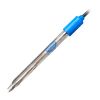Hach sensION+ 5044 Reference Electrode
Features
- Lithium acetate electrolyte recommended for all Hach sensION+ half-cell ISE's
- Guarded against contamination
- Quick measurement stabilization with large ceramic junction
- Free ground shipping
- Expedited repair and warranty service
- Lifetime technical support
- More
Overview
The Hach sensION+ 5044 Reference Electrode is a double junction reference electrode with a glass body and internal gel electrolyte, and 0.1M lithium acetate salt bridge. The reference probe has a large, replaceable ceramic diaphragm. The 5044 has a fixed 1-meter cable and banana connector for laboratory use with the Hach sensION+ MM374 Multimeter. The 5044 is recommended for use with all sensION+ half-cell ion selective electrodes (ISE) in drinking water, wastewater and general water quality applications.
Design
The probe is easy to maintain and features a double junction design with an internal gel electrolyte, making the 5044 difficult to contaminate. Its large ceramic junction provides a substantial surface area for contact between the reference electrolyte and sample, shortening the time required for measurement stabilization.
In The News
Ocean acidification: University of Washington's giant plastic bags help control research conditions
With oceans becoming more acidic worldwide, scientists are getting creative in designing experiments to study them. For example, one group at the University of Washington is using giant plastic bags to study ocean acidification. Each bag holds about 3,000 liters of seawater and sits in a cylinder-like cage for stability. The group at UW, made up of professors and students, is controlling carbon dioxide levels in the bags over a nearly three-week period, during which they are looking at the effects of increased acidity on organisms living near the San Juan Islands. “These mesocosms are a way to do a traditional experiment you might do in a lab or classroom,” said Jim Murray, professor of oceanography at the University of Washington.
Read MoreNOAA Alaska buoy network to monitor North Pacific ocean acidification
National Oceanic and Atmospheric Administration scientists detected signs of ocean acidification in the waters that hold the vulnerable and valuable fisheries of the North Pacific off the coast of Alaska, but they only had a snapshot of the action. “We know that in this place were important commercial and subsistence fisheries that could be at risk from ocean acidification,” said Jeremy Mathis, a NOAA Pacific Marine Environmental Laboratory researcher and professor at the University of Alaska Fairbanks. To understand how ocean acidification affects the North Pacific, NOAA scientists created a mooring network that collects constant in situ data on parameters contributing to acidification. They hope it will reveal seasonal trends and patterns left out by their snapshots.
Read MoreThree Decades of Research at Acton Lake
A multi-disciplinary team at Miami University, Ohio, has been studying the environmental change at Acton Lake for over three decades. Using three different NexSens buoys over this time, the team has an incredible archive of data that is helping build a picture of Acton’s past, present, and future. Until recently, a NexSens CB-50 buoy was used alongside other environmental monitoring at Acton Lake. In May 2025, the Miami team deployed a new XB-200 buoy , future-proofing their ongoing monitoring using real-time buoy systems. Acton Lake, a small hypereutrophic reservoir in southwest Ohio, covers 2.4km² and has a maximum depth of about 8m. The dam was built in 1956, and the lake has a large agricultural watershed.
Read More












